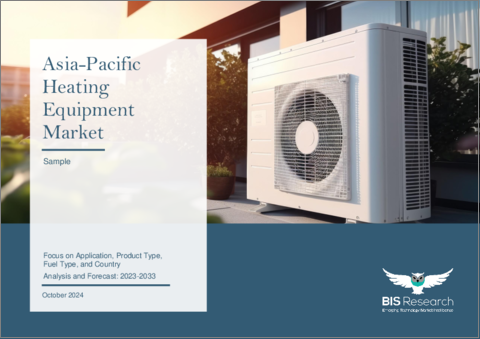|
|
市場調査レポート
商品コード
1575553
アジア太平洋の暖房機器市場:用途別、製品タイプ別、燃料タイプ別、国別 - 分析と予測(2023年~2033年)Asia-Pacific Heating Equipment Market: Focus on Application, Product Type, Fuel Type, and Country - Analysis and Forecast, 2023-2033 |
||||||
カスタマイズ可能
|
|||||||
| アジア太平洋の暖房機器市場:用途別、製品タイプ別、燃料タイプ別、国別 - 分析と予測(2023年~2033年) |
|
出版日: 2024年10月22日
発行: BIS Research
ページ情報: 英文 74 Pages
納期: 1~5営業日
|
- 全表示
- 概要
- 図表
- 目次
アジア太平洋の暖房機器の市場規模は、2023年の489億1,000万米ドルから2033年には958億5,000万米ドルに達し、予測期間の2023年~2033年のCAGRは6.96%になると予測されています。
持続可能性を求める世界の動向は、アジア太平洋の暖房機器市場にますます影響を与えており、最先端の暖房ソリューションへの投資に拍車をかけています。これには、ヒートポンプや太陽熱暖房のような代替技術の利用拡大と、ボイラーや炉のような従来型システムの改良の両方が含まれます。環境の持続可能性とエネルギー効率を重視した結果、高効率暖房システムの使用を促進するための規制やインセンティブが地域全体で整備されつつあります。
中国、韓国、日本といったアジア太平洋諸国政府は、効率的な暖房システムや再生可能エネルギー源の採用を奨励する政策を積極的に打ち出しています。エネルギー効率の改善やカーボンフットプリントの削減を目的とした減税や補助金などの制度により、最新の暖房技術に対する需要はさらに高まっています。エネルギー規制が強化されるにつれ、エネルギー効率の高いシステムの採用が加速し、アジア太平洋の暖房機器市場を押し上げると予想されます。
| 主要市場統計 | |
|---|---|
| 予測期間 | 2023年~2033年 |
| 2023年の評価 | 489億1,000万米ドル |
| 2033年の予測 | 958億5,000万米ドル |
| CAGR | 6.96% |
アジア太平洋の暖房機器市場は、持続可能でエネルギー効率の高い製品に対する需要の高まりにより、大きく拡大しています。APAC諸国は、二酸化炭素排出量の削減とエネルギー効率の向上を目指す世界の動きに対応して、暖房技術の近代化に多額の投資を行っています。これには、ボイラーや炉のような従来のシステムの開発だけでなく、ヒートポンプや太陽熱暖房のような代替品の使用も含まれます。
中国、インド、日本、韓国などのAPAC主要国では、急速な都市化、産業成長、エネルギー消費の増加により、最新の暖房システムがますます必要になってきています。エネルギー効率の高い暖房ソリューションの使用を奨励するため、この地域全体の政府は厳しい法律とインセンティブを導入しています。日本のエネルギー効率補助金や中国の再生可能エネルギー法などのイニシアチブは、低排出暖房ソリューションの採用を促進しています。
当レポートでは、アジア太平洋の暖房機器市場について調査し、市場の概要とともに、用途別、製品タイプ別、燃料タイプ別、国別の動向、および市場に参入する企業のプロファイルなどを提供しています。
目次
エグゼクティブサマリー
第1章 市場
- 動向:現在および将来の影響評価
- サプライチェーンの概要
- 研究開発レビュー
- 規制状況
- 市場力学:概要
第2章 地域
- 地域別概要
- 促進要因と抑制要因
- アジア太平洋
第3章 市場-競合ベンチマーキングと企業プロファイル
- 今後の見通し
- 地理的評価
- DAIKIN INDUSTRIES, Ltd.
- LG Electronics
- SAMSUNG ELECTRONICS CO., LTD.
- Hitachi, Ltd.
- FUJITSU GENERAL
- Midea Group
- Mitsubishi Electric Corporation
第4章 調査手法
List of Figures
- Figure 1: Region with Largest Share of Market, 2022, 2026, and 2033
- Figure 2: Asia-Pacific Heating Equipment Market (by Application), 2022, 2026, and 2033
- Figure 3: Asia-Pacific Heating Equipment Market (by Product Type), 2022, 2026, and 2033
- Figure 4: Asia-Pacific Heating Equipment Market (by Fuel Type), 2022, 2026, and 2033
- Figure 5: Heating Equipment Market, Recent Developments
- Figure 6: Supply Chain and Risks within the Supply Chain
- Figure 7: Value Chain Analysis
- Figure 8: Patent Analysis (by Country), January 2020-December 2023
- Figure 9: Patent Analysis (by Year), January 2020-December 2023
- Figure 10: Impact Analysis of Market Navigating Factors, 2023-2033
- Figure 11: Building construction and energy efficiency investments in 2019/2020
- Figure 12: Annual Energy Cost (US$)
- Figure 13: Crude Oil Prices ($/Barrel)
- Figure 14: China Heating Equipment Market, $Million, 2022-2033
- Figure 15: India Heating Equipment Market, $Million, 2022-2033
- Figure 16: Japan Heating Equipment Market, $Million, 2022-2033
- Figure 17: South Korea Heating Equipment Market, $Million, 2022-2033
- Figure 18: Rest-of-Asia-Pacific Heating Equipment Market, $Million, 2022-2033
- Figure 19: Strategic Initiatives, 2020-2023
- Figure 20: Share of Strategic Initiatives
- Figure 21: Data Triangulation
- Figure 22: Top-Down and Bottom-Up Approach
- Figure 23: Assumptions and Limitations
List of Tables
- Table 1: Market Snapshot
- Table 2: Heating Equipment Market, Opportunities
- Table 3: Trends: Overview
- Table 4: Heating Equipment Market (by Region), Thousand Units, 2022-2033
- Table 5: Heating Equipment Market (by Region), $Million, 2022-2033
- Table 6: Asia-Pacific Heating Equipment Market (by Application), Thousand Units, 2022-2033
- Table 7: Asia-Pacific Heating Equipment Market (by Application), $Million, 2022-2033
- Table 8: Asia-Pacific Heating Equipment Market (by Product Type), Thousand Units, 2022-2033
- Table 9: Asia-Pacific Heating Equipment Market (by Product Type), $Million, 2022-2033
- Table 10: Asia-Pacific Heating Equipment Market (by Fuel Type), Thousand Units, 2022-2033
- Table 11: Asia-Pacific Heating Equipment Market (by Fuel Type), $Million, 2022-2033
- Table 12: China Heating Equipment Market (by Application), Thousand Units, 2022-2033
- Table 13: China Heating Equipment Market (by Application), $Million, 2022-2033
- Table 14: China Heating Equipment Market (by Product Type), Thousand Units, 2022-2033
- Table 15: China Heating Equipment Market (by Product Type), $Million, 2022-2033
- Table 16: China Heating Equipment Market (by Fuel Type), Thousand Units, 2022-2033
- Table 17: China Heating Equipment Market (by Fuel Type), $Million, 2022-2033
- Table 18: India Heating Equipment Market (by Application), Thousand Units, 2022-2033
- Table 19: India Heating Equipment Market (by Application), $Million, 2022-2033
- Table 20: India Heating Equipment Market (by Product Type), Thousand Units, 2022-2033
- Table 21: India Heating Equipment Market (by Product Type), $Million, 2022-2033
- Table 22: India Heating Equipment Market (by Fuel Type), Thousand Units, 2022-2033
- Table 23: India Heating Equipment Market (by Fuel Type), $Million, 2022-2033
- Table 24: Japan Heating Equipment Market (by Application), Thousand Units, 2022-2033
- Table 25: Japan Heating Equipment Market (by Application), $Million, 2022-2033
- Table 26: Japan Heating Equipment Market (by Product Type), Thousand Units, 2022-2033
- Table 27: Japan Heating Equipment Market (by Product Type), $Million, 2022-2033
- Table 28: Japan Heating Equipment Market (by Fuel Type), Thousand Units, 2022-2033
- Table 29: Japan Heating Equipment Market (by Fuel Type), $Million, 2022-2033
- Table 30: South Korea Heating Equipment Market (by Application), Thousand Units, 2022-2033
- Table 31: South Korea Heating Equipment Market (by Application), $Million, 2022-2033
- Table 32: South Korea Heating Equipment Market (by Product Type), Thousand Units, 2022-2033
- Table 33: South Korea Heating Equipment Market (by Product Type), $Million, 2022-2033
- Table 34: South Korea Heating Equipment Market (by Fuel Type), Thousand Units, 2022-2033
- Table 35: South Korea Heating Equipment Market (by Fuel Type), $Million, 2022-2033
- Table 36: Rest-of-Asia-Pacific Heating Equipment Market (by Application), Thousand Units, 2022-2033
- Table 37: Rest-of-Asia-Pacific Heating Equipment Market (by Application), $Million, 2022-2033
- Table 38: Rest-of-Asia-Pacific Heating Equipment Market (by Product Type), Thousand Units, 2022-2033
- Table 39: Rest-of-Asia-Pacific Heating Equipment Market (by Product Type), $Million, 2022-2033
- Table 40: Rest-of-Asia-Pacific Heating Equipment Market (by Fuel Type), Thousand Units, 2022-2033
- Table 41: Rest-of-Asia-Pacific Heating Equipment Market (by Fuel Type), $Million, 2022-2033
Introduction to Asia-Pacific Heating Equipment Market
The Asia-Pacific heating equipment market is projected to reach $95.85 billion by 2033 from $48.91 billion in 2023, growing at a CAGR of 6.96% during the forecast period 2023-2033. The worldwide trend toward sustainability is influencing the APAC heating equipment market more and more, spurring investment in cutting-edge heating solutions. This encompasses both the increasing use of alternative technologies like heat pumps and solar heating as well as improvements to more conventional systems like boilers and furnaces. Regulations and incentives are being developed throughout the region to promote the use of high-efficiency heating systems as a result of the emphasis on environmental sustainability and energy efficiency.
Governments in APAC nations like China, South Korea, and Japan are aggressively putting policies into place to encourage the adoption of efficient heating systems and renewable energy sources. The demand for contemporary heating technology is further increased by programs like tax breaks and subsidies that are designed to improve energy efficiency and lower carbon footprints. As stricter energy regulations come into play, the adoption of energy-efficient systems is expected to accelerate, boosting the market for heating equipment in the APAC region.
| KEY MARKET STATISTICS | |
|---|---|
| Forecast Period | 2023 - 2033 |
| 2023 Evaluation | $48.91 Billion |
| 2033 Forecast | $95.85 Billion |
| CAGR | 6.96% |
Market Introduction
The Asia-Pacific (APAC) heating equipment market is expanding significantly due to rising demand for sustainable and energy-efficient products. APAC nations are making significant investments in modernizing heating technologies in response to the global movement to lower carbon emissions and increase energy efficiency. This covers the development of conventional systems like boilers and furnaces as well as the use of substitutes like heat pumps and solar heating.
Modern heating systems are becoming more and more necessary in major APAC economies like China, India, Japan, and South Korea due to rapid urbanization, industrial growth, and increased energy consumption. To encourage the use of energy-efficient heating solutions, governments throughout the region are putting strict laws and incentives into place. Initiatives such as Japan's energy-efficiency subsidies and China's Renewable Energy Law promote the adoption of low-emission heating solutions.
APAC's heating equipment market is also expanding as a result of the rise in smart city efforts and the construction of green buildings. Modern heating systems will likely be adopted more quickly as the region shifts to sustainable energy use, making the APAC heating equipment market a major contributor to the worldwide shift to sustainable energy solutions.
Market Segmentation
Segmentation 1: by Application
- Residential
- Commercial
- Industrial
Segmentation 2: by Product Type
- Heat Pumps
- Furnaces
- Boilers
- Others
Segmentation 3: by Fuel Type
- Natural Gas
- Oil
- Electricity
- Others
Segmentation 4: by Country
- Japan
- China
- India
- South Korea
- Rest-of-Asia-Pacific
How can this report add value to an organization?
Product/Innovation Strategy: The product segment helps the reader understand the different applications of the heating equipment products available in the market, which is poised for significant expansion with ongoing technological advancements, increased investments, and growing awareness of sustainable heating equipment solutions. Therefore, the heating equipment business is a high-investment and high-revenue generating model.
Growth/Marketing Strategy: The Asia-Pacific heating equipment market has been growing at a rapid pace. The market offers enormous opportunities for existing and emerging market players. Some of the strategies covered in this segment are mergers and acquisitions, product launches, partnerships and collaborations, business expansions, and investments. The strategies preferred by companies to maintain and strengthen their market position primarily include partnerships and collaborations.
Competitive Strategy: The key players in the Asia-Pacific heating equipment market analyzed and profiled in the study include heating equipment manufacturers. Additionally, a comprehensive competitive landscape such as partnerships, agreements, and collaborations are expected to aid the reader in understanding the untapped revenue pockets in the market.
Key Market Players and Competition Synopsis
The companies that are profiled have been selected based on inputs gathered from primary experts and analyzing company coverage, product portfolio, and heating equipment market penetration.
Some of the prominent names in this market are:
- DAIKIN INDUSTRIES, Ltd.
- LG Electronics
- SAMSUNG ELECTRONICS CO., LTD.
- Hitachi, Ltd.
- Midea Group
Table of Contents
Executive Summary
Scope and Definition
1 Markets
- 1.1 Trends: Current and Future Impact Assessment
- 1.1.1 Trends: Overview
- 1.1.2 Rising Focus on IoT- Enabled Heating Equipment Market
- 1.1.3 Focus on Energy Efficiency
- 1.2 Supply Chain Overview
- 1.2.1 Value Chain Analysis
- 1.2.2 Market Map
- 1.3 Research and Development Review
- 1.3.1 Patent Filing Trend (by Country, by Year)
- 1.4 Regulatory Landscape
- 1.5 Market Dynamics: Overview
- 1.5.1 Market Drivers
- 1.5.1.1 Rapid Expansion of Global Construction Projects
- 1.5.1.2 Environmental Consequences of the Greenhouse Effect
- 1.5.1.3 Incorporation of Renewable Energy Sources
- 1.5.2 Market Restraints
- 1.5.2.1 High Initial Capital Expenditure
- 1.5.2.2 Fluctuations in Energy Costs
- 1.5.3 Market Opportunities
- 1.5.3.1 Investment in Sustainable and Energy Efficient Heating Equipment Products
- 1.5.3.2 Rise in Partnerships and Collaborations Globally
- 1.5.1 Market Drivers
2 Regions
- 2.1 Regional Summary
- 2.2 Drivers and Restraints
- 2.3 Asia-Pacific
- 2.3.1 Regional Overview
- 2.3.2 Driving Factors for Market Growth
- 2.3.3 Factors Challenging the Market
- 2.3.4 Application
- 2.3.5 Product
- 2.3.6 Asia-Pacific (by Country)
- 2.3.6.1 China
- 2.3.6.2 India
- 2.3.6.3 Japan
- 2.3.6.4 South Korea
- 2.3.6.5 Rest-of-Asia-Pacific
3 Markets - Competitive Benchmarking & Company Profiles
- 3.1 Next Frontiers
- 3.2 Geographic Assessment
- 3.2.1 DAIKIN INDUSTRIES, Ltd.
- 3.2.1.1 Overview
- 3.2.1.2 Top Products/Product Portfolio
- 3.2.1.3 Top Competitors
- 3.2.1.4 Target Customers
- 3.2.1.5 Key Personnel
- 3.2.1.6 Analyst View
- 3.2.1.7 Market Share, 2022
- 3.2.2 LG Electronics
- 3.2.2.1 Overview
- 3.2.2.2 Top Products/Product Portfolio
- 3.2.2.3 Top Competitors
- 3.2.2.4 Target Customers
- 3.2.2.5 Key Personnel
- 3.2.2.6 Analyst View
- 3.2.3 SAMSUNG ELECTRONICS CO., LTD.
- 3.2.3.1 Overview
- 3.2.3.2 Top Products/Product Portfolio
- 3.2.3.3 Top Competitors
- 3.2.3.4 Target Customers
- 3.2.3.5 Key Personnel
- 3.2.3.6 Analyst View
- 3.2.3.7 Market Share, 2022
- 3.2.4 Hitachi, Ltd.
- 3.2.4.1 Overview
- 3.2.4.2 Top Products/Product Portfolio
- 3.2.4.3 Top Competitors
- 3.2.4.4 Target Customers
- 3.2.4.5 Key Personnel
- 3.2.4.6 Analyst View
- 3.2.5 FUJITSU GENERAL
- 3.2.5.1 Overview
- 3.2.5.2 Top Products/Product Portfolio
- 3.2.5.3 Top Competitors
- 3.2.5.4 Target Customers
- 3.2.5.5 Key Personnel
- 3.2.5.6 Analyst View
- 3.2.6 Midea Group
- 3.2.6.1 Overview
- 3.2.6.2 Top Products/Product Portfolio
- 3.2.6.3 Top Competitors
- 3.2.6.4 Target Customers
- 3.2.6.5 Key Personnel
- 3.2.6.6 Analyst View
- 3.2.7 Mitsubishi Electric Corporation
- 3.2.7.1 Overview
- 3.2.7.2 Top Products/Product Portfolio
- 3.2.7.3 Top Competitors
- 3.2.7.4 Target Customers
- 3.2.7.5 Key Personnel
- 3.2.7.6 Analyst View
- 3.2.1 DAIKIN INDUSTRIES, Ltd.
4 Research Methodology
- 4.1 Data Sources
- 4.1.1 Primary Data Sources
- 4.1.2 Secondary Data Sources
- 4.1.3 Data Triangulation
- 4.2 Market Estimation and Forecast






